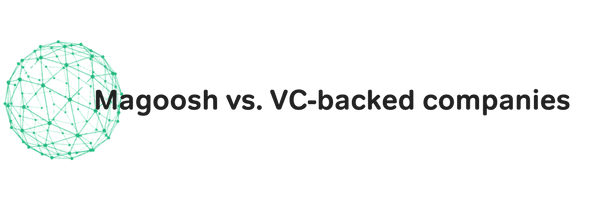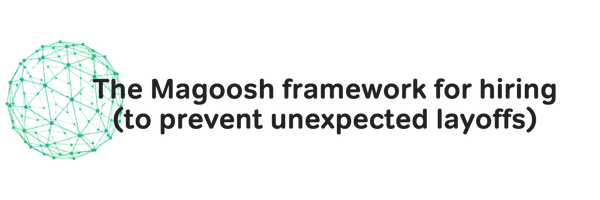Founders have big dreams when they start a company. They dream of changing the world and creating jobs. They dream of building a fast-growing enterprise used by millions or, in some cases, billions. They don’t, however, dream of laying people off. But unfortunately, that happens all too often.
In the past year, a number of companies I admire—including Moz, Treehouse, and Buffer—have had to make layoffs. Hoping to shed light on the issue, those companies chose to be open about their cuts and published articles here, here, and here about their struggles. Three businesses making layoffs may not seem like a big deal, but they represent only a small portion of the layoffs that happened last year. And with most layoffs going unannounced, the truth is we still have only a small glimpse of how widespread the problem really is.
At Magoosh, a startup based in the Bay Area, we’re vastly aware of the uptick in layoffs happening around us. But rather than shutting our eyes and waiting to see what happens, we’ve made it a priority to understand why cuts happen and actively work to avoid them. Taking a cue from Moz, Treehouse, Buffer, and others who have written on the subject, I’d like to share our own thoughts on layoffs: what we’ve learned about why they happen, how we approach risk-taking at Magoosh as a result, and how we implemented our own layoff-preventing practices.
By having more open conversations about layoffs, it’s my hope that we can promote more understanding around them and collectively start making better business decisions at the intersection of risk-taking, growth, and hiring.

Layoffs can happen for a number of reasons. Every company is different, after all. So, let’s focus on one prevalent reason that has widely affected companies in the tech space.
Startups, especially Silicon Valley venture-backed startups, are encouraged to chase growth. Growth can take the form of more users, more revenue, or more of something else. The hope is that high growth (often unprofitable growth) will lead to more funding which will lead to more growth and so on. At some point the company, usually after it has a very large user base, will focus on profit with the thought that high growth at first could lead to more long-term profit. But there’s a natural tension between growth (i.e. market share) and profit, and it’s a tension that has existed long before the dot-com bubble in the early 2000’s. In fact, the Harvard Business Review published an article on the subject as far back as 1975.
VC firms have investors who are expecting a 6x return on their investment over a period of 10 years. In order to achieve that level of success, VCs need some of their companies to achieve massive outcomes (100x or higher), given that most of their portfolio companies will fail or return very little. Because of this, VCs are incentivized to invest in startups that aim for big growth—startups that are willing to lose money month-over-month in order to grow the top line faster. When founders take VC money, they are implicitly promising they will chase growth, not profit.
Targeting growth (over profit) can be a smart approach for many companies, especially companies in a winner-take-most market. For example, Facebook, Twitter, Snapchat, and the like would not have reached their levels of success if they focused on profit early on. However, most companies are not Facebook, Twitter, or Snapchat. And most companies don’t realize what they’re getting into with the growth-before-profit approach. Too many of these companies—energized by Silicon Valley’s seemingly free-flowing cash and pervasive “growth at all costs” message—end up chasing growth (to get that next round of funding), when in reality they should be focused on nailing down their value prop and developing a path to profitability.
The growth-focused approach can be painful when it doesn’t work—and for most startups it doesn’t. Every founder anticipates some level of failed experimentation (“This product might fail, that’s fine”), but what they don’t usually think through is the people side of the product. In other words, when you raise a lot of money and hire a lot of people to build a product and then it fails, you’re not only faced with dropping a product, you’re faced with laying people off.
Example: When failed experiments lead to layoffs
I’ve looked up to Moz since the early days of Magoosh (2011). I’ve read many blog posts, especially the ones by their founder Rand, on how to approach content marketing and how to approach building a company. Moz and Rand have played a big part in Magoosh’s growth and my own growth.
So, in late 2016, I was sad to learn that Moz was announcing layoffs. From their CEO, Sarah Bird:
This is the gut-wrenchingly painful part. The hardest part of my job is asking people who have put their hearts and souls into Moz to part ways. To align the organization with this strategic shift, we will be asking about 28% of Mozzers to leave. They are a part of the Moz family and it is heartbreaking that they will not be working alongside us in the future.
Moz had raised $29M to-date, a small early round, then $18M in 2012 and another $10M in 2016. While I don’t know the specifics, I suspect they raised the $18M round based on the success they had up to that point, and on a big future vision of becoming more than an SEO company—eventually becoming the leading provider of tools for all inbound marketing. This was a big experiment and a big risk. And after four years, they realized the risk didn’t work out the way they hoped, which led to laying off 28% of their staff.
Running a startup is a constant exercise in risk assessment. Sometimes big risks pay off and sometimes, as in Moz’s case, they don’t. And the truth is that those layoffs—while difficult—were likely the right decision for Moz in the long-term. Moz’s experience is just one example of what many startups go through. It’s why many layoffs happen and will continue to happen. So, what can companies do? Are layoffs an inevitable consequence of taking risks?

At Magoosh, we approach business and risk-taking differently. We raised a small round of capital to get us off the ground at the beginning, and since then we’ve made it a point to spend only the money that we have, using funds from our most-successful product lines to expand into new product lines and markets. It’s made us a stronger company and it’s insulated us from the rising tide of layoffs throughout the Bay Area, while allowing us to still take calculated risks.
So, what do our business decisions look like in action? Below, I’ve outlined some scenarios that many companies face. Then, I explain how a VC-backed growth-focused company would approach each scenario and compare it to how we would approach that same scenario at Magoosh.
Scenario 1: Launching one (or several) new product lines
Magoosh is an online test prep company, and we periodically add prep products for new exams. For instance, we recently launched an MCAT prep product for aspiring doctors, and we have plans to add more exams in the future. Let’s see how the approach to adding exams differs.
VC-backed approach:
- Identify the exams the company wants to pursue and focus on those that have very large market sizes.
- Build a model for the growth trajectory of those exams and determine how much capital is required and do some light validation (e.g. surveys, etc.).
- Launch and build as many exam products as possible, staying within the capital constraint, and hire people to work on those products.
Magoosh approach:
- Identify the exams that we want to pursue, focusing not only on those that have a sizeable market, but also those that could quickly be ROI+.
- Validate demand for these exams by building an audience first, before potentially building a product. This validation can take 6-9 months.
- Only create products for the exams for which we successfully built an audience.
Tradeoffs:
The VC-backed approach can lead to faster growth since the products are created earlier. If there’s a first-mover advantage, then the benefit of faster growth could be significant, and as we discussed before, faster growth can also help the company raise their next round of funding. However, if many of the new products are not successful, the VC-backed approach could lead to significant lost capital and could result in layoffs for the people hired onto some of the new teams.
Scenario 2: Developing a new growth channel—outbound sales
At Magoosh, we recently decided to experiment with outbound sales. We had seen some indication of market interest based on inbound group purchase requests and believed this channel had more potential. Let’s see how the approach to experimenting with outbound sales could differ:
VC-backed approach:
- Determine the potential of outbound sales and then hire an individual or several individuals to grow revenue, depending on capital available.
- Continue pursuing outbound sales for 2-3 years even if it’s losing money, that is as long as there is some positive signal. If it pays off then it could pay off in a big way and grow top-line revenue in the meantime.
Magoosh approach:
- Identify outbound sales as an opportunity and potentially hire a contractor or intern to pursue it rather than hiring someone full-time.
- If we decide to hire someone, explicitly let them know that this is an experiment so there’s more risk in this role than there would be in other roles, and look for a more significant positive signal before hiring others onto that team.
Tradeoffs:
If the outbound sales is successful, the VC-backed approach will almost certainly lead to faster growth. And some experiments need time in order to demonstrate a return, so the Magoosh approach of hiring a contractor or intern may not provide enough time to assess whether outbound sales was successful. The Magoosh approach, however, leads to lower capital expenditure and provides more clarity on the uncertainty of the future of the role. The VC-backed approach could lead to layoffs if the new channel is not successful.
In both of the scenarios above, the VC-backed approach can lead to faster growth, and if successful, is likely better overall. Our company’s approach protects against lost capital and layoffs, meaning it’s better in the failure case (which, in the world of start-up experiments, is the most likely outcome), as it can still lead to profitability. And even though our approach can mean slower growth, we think of it as a long-term approach worth carving out time for.
For what it’s worth, our approach hasn’t kept Magoosh from attaining high-growth or profitability. We became cash-flow positive in 2012 and continue to grow quickly year-over-year, even achieving a top 100 place on the Inc. 5000 in 2016.
Perhaps, some might say, we could have achieved that more rapidly if we had employed a VC-backed approach to growth, but I believe making time to build a risk model to mitigate the chance of layoffs was the right move for us in the long run. And I believe if more VC-backed companies acted as if they were chasing profitability, even if in reality they were chasing growth, they could mitigate their own layoffs because they had at least created some artificial constraints for themselves. Constraints are difficult to abide by, though, so at Magoosh we’ve developed our own framework to keep us on track.

Over the years, we’ve developed a framework for how we approach risks, especially as they relate to people. When a manager wants to hire for a new role, we go through the following questions:
- What’s the expected benefit of this role? Estimate which metrics will move, by how much, and by when.
- Is the work experimental in nature? If yes, what happens if the experiment doesn’t work out?
- What is the time-frame for this role? What will this person be doing in 6 months, in 1 year, in 2 years? If the person’s work/project will end or will no longer be a company priority, what will we do? Should we hire a contractor instead?
These questions help us understand the expectations and risks associated with each role. We then try to communicate these expectations and risks to each candidate (aligning with our value of Communication > Efficiency). We realize this approach can make it harder to fill positions. Because we’re upfront about the potential risk in our temp and experimental roles—while they may not actually be that risky in reality—people might turn down those roles in favor of full-time positions elsewhere that they perceive as being less risky. We’re comfortable with that trade-off, though. If the experiment doesn’t work out for any reason, we know the person opted into the risk.
Our approach has its own issues. While we try to take risks, our risks are generally smaller than those of the companies that have raised a lot of capital. This means we’re less likely to see the massive 100x successes. For now, it’s a tradeoff we’re comfortable with, as we believe it’s an approach that works best for our company and our team.
Now that you’ve read all about our approach to risk-taking, layoffs, and hiring, I need to make one thing clear: We’re not so naive to think Magoosh is immune from layoffs. We recognize that for any number of reasons—changes in the market, the end of the GRE as we know it—could lead us to make our own tough cuts. That will always be the reality. But I believe the existence of layoffs—the fact that they will always happen in business—is not a good enough reason not to take steps to minimize their potential. If we didn’t at least try, we would not be doing right by our employees or our company.
I’ve shared what we’re doing; now I’d love to hear from you as well. If you’re using other tactics at your company, or disagree with any of those we’re using here, please leave a note for me in the comments. Let’s continue to make this an open discussion, so that we can all—Magoosh included—get better at understanding, preventing, and addressing layoffs.
Thanks to AJ Shankar (Everlaw), Joel Gascoigne (Buffer), Tawheed Kader (ToutApp, now Marketo), Andrew Cronk (Re-factor) and Greg McVerry (ReVIEW Talent Feedback) for reviewing and providing feedback on this article.

Leave a Reply